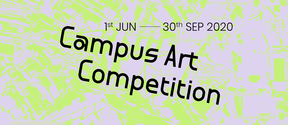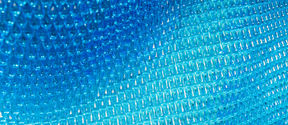Winners in the campusart competition rooted in bioart and quantum physics
Laura Piispanen, Noora Heiskanen, Jenna Ahonen and Ayda Grisiute convinced the jury with their creativity.
Aalto University launched an invited art competition in 2020, with the aim of which is to get feasible proposals for works of art found on the Otaniemi campus. There were two winning entries: bio.modules.way and Quantum Moss. The first one has arrived to Otaniemi campus.
Designed and created by Aalto University alums Jenna Ahonen and Ayda Grišiūtė, bio.modules.way is temporarily on the second floor outside the auditorium B in the Undergraduate Centre. The piece will later be installed next to Dipoli when the outdoor renovation project near it is completed.
Ahonen and Grišiūtė aim to design for decay as a critical part of a sustainable lifecycle for art. The artists were also able to set up a company during commission and plan to continue developing projects in the future together.
The installation is composed of two main elements: the wooden structure as the skeleton and the tiles made from a frame and a bioplastic infill as the flesh. The piece expresses the evolution of woodcraft and its materiality in all its different forms. The skeleton itself as wood, the frames as 3D printed wood-based filament, and the bioplastic including cellulose as a main co-polymer in the formula.
According to Ahonen and Grišiūtė, the shape of the tiles comes from a vegetative bud sprouting from its supportive stem. While not yet a leaf, the buds symbolise a transitional moment of growth and development for plants.
The tiles will continuously change according to the local environmental conditions near Dipoli, the installation will offer a unique experience at different times. The artists encourage everyone to visit bio.modules.way several times during all kinds of weather and throughout different seasons. Visitors can also very gently touch the tiles to see how they change.
Airy and nature-inspired, the installation is very approachable and welcoming. bio.modules.way will at its final site invite the bypasser to take a closer look at how it gradually returns to nature. As the piece changes over time, the artists will record the process in a series of photographs.
bio.modules.way will biodegrade in phases – from the flesh of the tiles first to the underlying wooden structural skeleton at the end. The piece was designed to challenge our understanding of permanence within the built environment. When scaled up, it creates a breathing architecture that adapts to and activates specific site conditions rather than tries to control them.
Reactive to local weather conditions, the tiles, or bio.modules, expand and contract based on their internal moisture levels, continuously shifting the geometry of the individual tile. The changes to the artwork will be visible after it has been installed to its final location next to Dipoli.
In 2017, Aalto University decided to comply with a one per cent art principle in its building projects. The campus art competition is the university’s fifth project, where approximately one per cent of a building project's allocation is allocated to art purchases. The one per cent art principle was first applied to the Radical Nature art concept in Aalto University’s main building, Dipoli.
The vision of public art at Aalto University is to address and raise questions about what it is to be a university, what we do together in society, and what constitutes the public. Public art is site-specific and connects with the diversity of the university and its post-disciplinary communities. Public artworks reflect this diversity through different art forms, materials, techniques and traditions.
More information
Outi Turpeinen, Senior Specialist, art and exhibitions
[email protected]
tel. 050 431 4194
Jenna Ahonen, artist
[email protected]
Ayda Grišiūtė, artist
[email protected]

Laura Piispanen, Noora Heiskanen, Jenna Ahonen and Ayda Grisiute convinced the jury with their creativity.

The aim of public art across Aalto is to create a vibrant environment for experiencing the world through various perspectives and for embracing imagination, intuition, and exploration.


